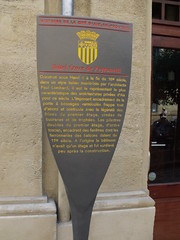King Henry II of France
Commemorated on 1 plaque
Hôtel Croze de Peyronetti Construit sous Henri II à la fin du 16e siècle, dans un style italien maniériste par l'architecte Paul Lombard, il est la représentant le plus caractéristique des architectures privées d'Aix pour ce siècle. L'impostant encadrement de la porte à bossages vermiculés frappe tout d'abord et contraste avec la légéreté des frises du premier étage, ornées de bucranes et de trophées. Les pilastres doubles du premier étage, d'ordre toscan, encadrent des fenêtres dont les ferronneries des balcons datent du 17e siècle. A l'origine le bâtiment n'avait qu'un étage et fut surélevé peu aprés la construction.
English translation: Hotel Croze de Peyronetti built under Henry II in the late 16th century in an Italian Mannerist style by architect Paul Lombard, it is the most characteristic representative of private Aix architectures for this century. The impostant doorway to vermiculated bosses strikes first and contrasts with the lightness of the first floor friezes adorned with bucrania and trophies. Double pilasters of the first floor of Tuscan order, frame windows with wrought iron balconies from the 17th century. Originally the building had only one floor, which was raised soon after construction.
Rue de l'Aude, Aix-en-Provence, France where they built under


